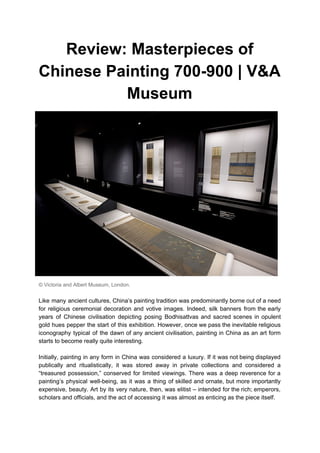
Untitleddocument
- 1. Review: Masterpieces of Chinese Painting 700900 | V&A Museum © Victoria and Albert Museum, London. Like many ancient cultures, China’s painting tradition was predominantly borne out of a need for religious ceremonial decoration and votive images. Indeed, silk banners from the early years of Chinese civilisation depicting posing Bodhisattvas and sacred scenes in opulent gold hues pepper the start of this exhibition. However, once we pass the inevitable religious iconography typical of the dawn of any ancient civilisation, painting in China as an art form starts to become really quite interesting. Initially, painting in any form in China was considered a luxury. If it was not being displayed publically and ritualistically, it was stored away in private collections and considered a “treasured possession,” conserved for limited viewings. There was a deep reverence for a painting’s physical wellbeing, as it was a thing of skilled and ornate, but more importantly expensive, beauty. Art by its very nature, then, was elitist – intended for the rich; emperors, scholars and officials, and the act of accessing it was almost as enticing as the piece itself.
- 2. This type of intended viewing would have inevitably dictated the types of images Chinese painting produced, but it might also partially explain the typical forms in which it came. For instance, the silk scroll that opens out like a comic strip from right to left, and rolls up as quickly as it rolls out. Also, the handheld fan and small prints intended for personal albums – all meant for delicate use and safekeeping. What is interesting, then, and perhaps what we must always remember as Western viewers of occidental art, is that the functions of such art forms often differ from ours as much as its themes and socialcultural contexts do. The themes and subjects of early Chinese painting, however, are equally as fascinating as its forms, and as nature played a big part in the evolution of the Chinese sensibility, it is an overarching theme in the painting of the early dynasties. Therefore, the bulk of the first half of the exhibition is necessarily occupied by 山水 : Shānshuǐ (landscape) paintings. What becomes fascinatingly clear here is that “nature versus man” is a huge preoccupation for early painters. This theme ties in with Buddhist and Taoist ideas of Man attempting to manage, or order, nature so as to be at one with it, but also ideas of Man being dominated by nature, and nature as an allencompassing force upon the world. This can be seen repeatedly in the stark silk hangings depicting scenes of nature at its most uncontrollable, tyrannical and overbearing – storms; ocean waves; mountainous climes. It is nature plucked at its most aesthetically pleasing prime. Due to the importance of the subject matter to the Chinese sensibility, Shānshuǐ paintings also influenced the next clear evolutionary step for Chinese painting from delicate, protected images to everexpanding silk banners and hangings. What this is most indicative of is an economic progression in China, and the natural adaptation in the way society wanted to manifest its wealth also gave way to a desire to display and exhibit this prosperity. Suddenly, and in great contrast with tradition, paintings were meant for prominent display. Paintings became vast and elaborate, blending calligraphy, poetry and painting together as a clear exhibition of the nation’s scholars’ multidisciplinary talents. Poems about nature, for instance, are written out in calligraphy and pictorially narrated by the classic grand imagery seen in Shānshuǐ paintings. This is another interesting development that Masterpieces of Chinese Painting almost accidentally charts – the growth of wealth in China and its effect on painting as an art form. Interestingly, with wealth came opulence, abundance and, naturally, more art. But more importantly, with wealth came the desire to flaunt such luxury. And following on from the monolithic grandeur of Shānshuǐ paintings, we begin to see the exhibition of art merging with the collection of art. Paintings start being littered with the seals of artists, owners and multiple collectors, a bit like autograph collection in the West. Thus, the ego of Chinese painting was born, and the next natural progression was the human subject itself. Once again, function and theme in Chinese painting adapts itself to society and culture – the depictions of natural magnificence sit side by side with portraits of emperors, court officials and rich family heads. One painting blurb within the exhibition describes the motivation of Chinese painters as ‘an enthusiasm for the visible world’. Perhaps this somewhat sums up the history of Chinese painting, in brief. There is a noticeable attentiveness to what is literally in front of the artist –
- 3. for instance, religious fervour; huge and humbling natural forces; human nature, in their richest, most opulent state. And this inturn influences a work of art’s purpose; its status, and the status of its owners.